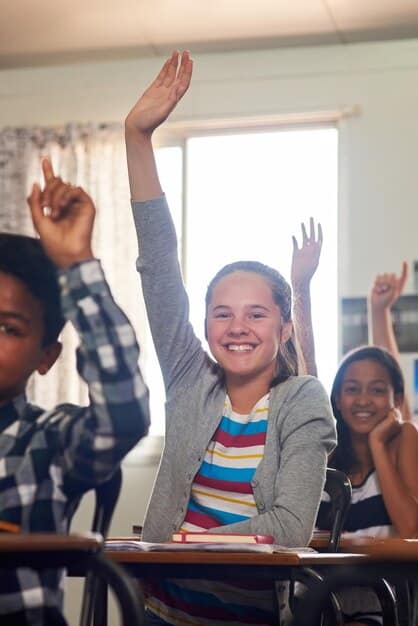Standardized Testing Debated: Pros & Cons in Current Education System

The debate surrounding standardized testing is multifaceted, with proponents highlighting its role in accountability and measuring educational progress, while critics argue it promotes narrow curricula, exacerbates inequity, and fails to capture holistic student abilities, prompting extensive discussion among educators and policymakers.
The conversation around the debate over standardized testing: experts weigh in on the pros and cons of the current system is one that continually shapes educational policy and public discourse. This topic probes into the very foundation of how we measure learning, assess school effectiveness, and prepare students for future endeavors. The complexities involved span pedagogical philosophies, socio-economic disparities, and the very definition of academic success.
Understanding Standardized Testing: A Historical Perspective
The origins of standardized testing in the US can be traced back to the early 20th century, particularly influenced by the industrial revolution’s push for efficiency and quantifiable outcomes. Initially conceived to identify learning disabilities and assess military recruits, their role expanded significantly following Sputnik’s launch in 1957, emphasizing scientific and mathematical prowess. This historical trajectory reveals a tool that has consistently adapted its purpose, from diagnostic to accountability-driven.
The mid-20th century saw the proliferation of standardized tests beyond specialized uses into mainstream education, becoming instruments for college admissions and, eventually, school accountability. The National Defense Education Act of 1958, a direct response to Cold War anxieties, heavily promoted educational reforms, including the use of standardized assessments to gauge student progress, particularly in science, mathematics, and foreign languages. This era cemented the idea that national interests were intertwined with educational achievement, measurable through uniform metrics.
The 1980s marked another pivotal shift, with reports like “A Nation at Risk” decrying a perceived decline in American educational standards. This led to increased pressure for accountability and the widespread implementation of state-mandated standardized tests. The belief was that by setting clear benchmarks and measuring performance against them, schools would be motivated to improve, and student achievement would rise. This period saw the tests become less about individual diagnosis and more about system-wide evaluation and comparison.
- Early 20th Century: Diagnostic tools for individuals.
- Post-Sputnik Era (1950s-60s): National security and academic rigor.
- 1980s: Accountability and perceived decline in standards.
- Early 2000s (No Child Left Behind): High-stakes testing for school improvement.
This historical evolution culminated in legislation such as the No Child Left Behind Act (NCLB) in 2002, which mandated annual testing in reading and math for students in grades 3-8 and once in high school. NCLB tied federal funding to test scores, creating a high-stakes environment where schools faced sanctions for failing to meet Adequate Yearly Progress (AYP). This legislation amplified the reliance on standardized tests as the primary metric for educational success, pushing them into the forefront of public and professional debate.
Today, while NCLB has been replaced by the Every Student Succeeds Act (ESSA) in 2015, which grants states more flexibility in their accountability systems, standardized testing remains a deeply entrenched component of the American education landscape. Its historical journey illustrates a continuous attempt to reconcile the diverse goals of education—from individual learning to national competitiveness—through a single, quantifiable mechanism. The debate, therefore, is not merely about testing, but about the very essence of what we value in education and how we choose to measure it.
The Core Arguments for Standardized Testing
Proponents of standardized testing often champion its role in promoting accountability and ensuring equity across diverse educational settings. They argue that these tests provide an objective, uniform metric for evaluating student performance, teacher effectiveness, and school quality, which can be invaluable for policymakers, parents, and educators alike.
Promoting Accountability and Data-Driven Improvement
One of the most frequently cited benefits is the ability of standardized tests to hold schools and districts accountable for student learning. By measuring all students against the same criteria, these tests can highlight areas where schools are succeeding or falling short. This data, proponents argue, enables targeted interventions and resource allocation to improve outcomes.
Ensuring Equity and Identifying Achievement Gaps
Standardized tests are often viewed as tools to ensure that all students, regardless of their socio-economic background, ethnicity, or location, receive a quality education. They can reveal achievement gaps between different demographic groups, prompting efforts to address disparities in educational opportunities. For example, if a particular demographic consistently underperforms on tests, it can signal systemic issues that need to be addressed. This ensures that every student gets a fair chance at academic success and provides a baseline for comparing educational outcomes across various districts.
Guiding Resource Allocation and Policy Decisions
The data generated by standardized tests can inform crucial policy decisions at federal, state, and local levels. This includes decisions regarding curriculum development, teacher training, and the distribution of educational funding. Policymakers can use test results to identify high-need areas and allocate resources accordingly, theoretically leading to more efficient and effective educational systems. The tests thus serve as a compass for directing educational reform efforts.
For example, a state might identify through test data that its students are struggling with specific mathematical concepts. This information can then lead to revised curricula, professional development for teachers in those areas, or the adoption of new teaching methodologies. Without a standardized measure, identifying such widespread deficiencies would be significantly more challenging, if not impossible. The uniform nature of these tests, therefore, provides a common language for discussing and addressing educational challenges at scale, allowing for comparisons that might not otherwise be possible given the vast diversity of school systems and student populations.
Furthermore, these tests offer parents a benchmark to understand their child’s academic progress in comparison to their peers. This can empower parents to engage more effectively with their child’s education, advocate for specific resources, or make informed decisions about school choice. From this perspective, standardized tests are not just about accountability for schools but also about providing transparency and information to the stakeholders most invested in student success. The clear and concise nature of test scores, however, has also been criticized for oversimplifying complex educational outcomes, a point often raised by critics of the current system.
The Primary Arguments Against Standardized Testing
While standardized tests are lauded for their accountability measures, a substantial body of criticism highlights their significant drawbacks. Critics argue that these tests, in their current form, often fail to measure true learning, exacerbate inequities, and narrow the educational experience.

Narrowing the Curriculum and Teaching to the Test
A principal concern is the phenomenon of “teaching to the test.” When high-stakes tests dictate school success, educators may feel compelled to focus instruction primarily on the content and format of the test, often at the expense of a broader, more enriching curriculum. This can stifle critical thinking, creativity, and the exploration of subjects not directly assessed.
- Reduced Subject Diversity: Less time spent on arts, music, and physical education.
- Rote Memorization: Emphasis shifts from deep understanding to recall of facts.
- Lack of Creativity: Teachers may avoid innovative approaches not aligned with test formats.
- Critical Thinking Hindered: Problem-solving skills that don’t fit multiple-choice questions are neglected.
Bias, Equity, and Socioeconomic Disparities
Critics vehemently argue that standardized tests are inherently biased against certain student populations, particularly those from low socio-economic backgrounds, racial and ethnic minorities, and English language learners. Factors such as access to test preparation resources, cultural relevance of test items, and test anxiety disproportionately affect these groups, leading to scores that may reflect systemic inequalities rather than actual academic ability.
For instance, questions on tests might inadvertently rely on cultural references or background knowledge that are more common among affluent, dominant cultural groups. This subtle cultural bias can put students from different backgrounds at a disadvantage, even if they possess equivalent intellectual capabilities. Additionally, wealthier families can afford expensive test prep courses and private tutors, further widening the gap between their children’s scores and those of less privileged students who lack such resources. This creates an uneven playing field, where test outcomes are more reflective of privilege than of a student’s inherent learning potential or the quality of instruction they received.
Measuring Limited Aspects of Intelligence and Learning
Another significant critique is that standardized tests offer a narrow snapshot of what students know and can do. They typically assess recall of factual information and basic comprehension, often through multiple-choice questions. This format struggles to capture essential skills like problem-solving, collaboration, communication, creativity, and critical thinking—all vital for success in the 21st century.
Educators argue that a student’s ability to thrive in a diverse world extends far beyond what a single test score can convey. A student might excel in a project-based learning environment, demonstrate exceptional leadership skills, or possess unique talents in areas like visual arts or engineering, none of which are adequately assessed by standardized exams. Relying heavily on these tests for evaluation can lead to an incomplete or even misleading picture of a student’s true capabilities and potential. This oversimplification often marginalizes talents and intelligences that do not conform to the quantifiable metrics of a standardized format, ultimately disserving both the students and the broader educational goals of fostering well-rounded individuals.
Expert Opinions on Accountability and Assessment
The dialogue among education experts regarding accountability and assessment is complex, often reflecting divergent views on how best to measure student progress and school effectiveness. This discussion is central to the debate over standardized testing, as it touches upon the very purpose of evaluation in education.
Some experts, often aligning with a more traditional view of educational measurement, emphasize the importance of external, objective accountability. They argue that standardized tests provide an essential mechanism for ensuring schools are meeting basic academic standards and for identifying areas where improvement is needed. These experts believe that without a uniform measure, it would be difficult to compare schools, evaluate the impact of educational reforms, or ensure that all students are receiving a foundational education. They often point to the utility of data generated by these tests for identifying achievement gaps and driving targeted interventions. From this perspective, accountability isn’t just about punitive measures but about providing transparent insights into system performance.
Conversely, many experts advocate for a more holistic approach to assessment, arguing that an overreliance on standardized tests distorts the true picture of student learning and school quality. They contend that while some form of accountability is necessary, it should extend beyond a single test score to encompass a broader range of indicators, including student growth, social-emotional learning, and the development of 21st-century skills. These experts emphasize the limitations of standardized tests in capturing the richness and complexity of the learning process, often suggesting that such tests incentivize rote memorization over deeper understanding and critical thinking. They propose alternative assessment methods that are more authentic and aligned with actual classroom instruction.
- Formative Assessments: Ongoing evaluations to inform teaching and learning.
- Performance-Based Assessments: Tasks requiring application of skills and knowledge.
- Portfolios: Collections of student work demonstrating growth over time.
- Student Feedback and Self-Assessment: Empowering students in their learning journey.
The push for alternative forms of assessment is gaining traction, particularly among experts who believe that the current system discourages innovative teaching practices. They argue that if schools are solely judged on test scores, teachers will inevitably narrow their curriculum to match test content, thereby failing to cultivate essential skills like creativity, collaboration, and complex problem-solving. These proponents of broader assessment frameworks believe that true accountability should encourage educational practices that prepare students for life, not just for tests. They often cite examples of schools or districts that have moved towards more diverse assessment portfolios and seen positive outcomes in terms of student engagement and deeper learning.
At the heart of this expert debate is the question of what we truly value in education. Is it the ability to perform well on a series of fixed assessments, or is it the development of well-rounded individuals equipped with a diverse set of skills and a lifelong love of learning? While most experts agree on the need for some form of accountability, the methods and scope of assessment remain a vigorously contended terrain, underscoring the ongoing challenge of crafting an educational system that serves all students equitably and effectively.
The Impact on Teachers and Classroom Practice
The pervasive presence of standardized testing profoundly influences the daily lives of teachers and the dynamics within classrooms. Educators often find themselves navigating a challenging landscape where the pressures of test scores shape pedagogical decisions, classroom climate, and even their professional identities.
Curriculum Alignment and Instructional Strategies
When standardized tests carry significant weight, teachers frequently feel compelled to align their curriculum and instructional strategies closely with the test content. This phenomenon, often referred to as “test prep,” can lead to a narrowing of the curriculum, where subjects not directly assessed receive less instructional time or are omitted entirely. Teachers might dedicate extensive periods to reviewing past test questions, teaching test-taking strategies, and conducting drills, sometimes at the expense of deeper conceptual understanding or more engaging, project-based learning. This can also lead to an unintended consequence: a curriculum that becomes less responsive to the diverse learning needs and interests of students. The emphasis shifts from fostering genuine curiosity and a love for learning to achieving measurable outcomes on a set date.
Teacher Morale and Professional Autonomy
The pressure associated with standardized tests can significantly impact teacher morale and professional autonomy. When teacher evaluations or school funding are directly tied to student test scores, it can create an environment of anxiety and burnout. Educators may feel that their professionalism is undermined, as their expertise in understanding individual student needs is overshadowed by a uniform metric. This can deter innovative teaching practices and discourage risk-taking in the classroom. Instead of focusing on personalized learning journeys, teachers might prioritize methods that promise the quickest route to higher scores, even if those methods do not promote holistic student development. The feeling of being constantly scrutinized based on a narrow set of data points can erode job satisfaction and lead many talented educators to leave the profession.
Moreover, the prescribed nature of test-driven curricula can limit teachers’ ability to respond to current events, incorporate local community issues, or follow student-led inquiries—all practices that can make learning more relevant and engaging. The emphasis on standardized outcomes can inadvertently reduce the role of the teacher from a creative facilitator of learning to a funnel for test-specific information. This challenge for teachers is not merely about adapting practices but about fundamental choices related to their professional identity and the purpose of education itself, creating a tension between being an educator and a test administrator.
Alternatives and Future Directions in Assessment
The criticisms leveled against current standardized testing practices have spurred a vigorous search for alternatives and innovative future directions in assessment. Educators, policymakers, and researchers are exploring methods that could offer a more comprehensive and equitable understanding of student learning and school effectiveness.
Performance-Based Assessments (PBAs)
One prominent alternative gaining traction is performance-based assessments. Unlike traditional multiple-choice tests, PBAs require students to demonstrate their knowledge and skills by performing a task or creating a product. This could involve designing an experiment, writing an essay, giving a presentation, or solving a complex real-world problem. PBAs are often seen as more authentic measures of learning, as they mirror the kinds of challenges students will face in higher education and professional life. They emphasize critical thinking, problem-solving, and creativity, which are often overlooked by standardized exams. The challenge with PBAs lies in their scalability and standardization of scoring, though advancements in technology and rubric development are helping to address these issues.
Portfolio Assessments and Student-Centered Approaches
Portfolio assessments represent another promising avenue. In this approach, students compile a collection of their work over time—including essays, projects, artwork, and reflections—to demonstrate their growth and mastery of skills. Portfolios provide a holistic view of learning, highlighting individual progress and allowing for the assessment of diverse talents and intelligences. This method empowers students to take ownership of their learning and showcase their strengths in multiple modalities. Student-centered approaches also include self-assessment and peer assessment, where students evaluate their own work and that of their peers, fostering metacognitive skills and a deeper understanding of learning criteria. While more time-intensive, portfolios offer rich, qualitative data about student learning that standardized tests cannot capture.
Adaptive Testing and Technology-Enhanced Assessments
Technological advancements are also opening new doors for assessment. Adaptive testing, for instance, adjusts the difficulty of questions in real-time based on a student’s responses, providing a more precise measure of their ability than a fixed-form test. Technology-enhanced items can also move beyond traditional multiple-choice to include simulations, interactive tasks, and drag-and-drop exercises, allowing for the assessment of more complex skills. These digital tools can also provide immediate feedback to students and teachers, making assessment a more integral part of the learning process rather than just an endpoint. Big data analytics and artificial intelligence are also being explored to derive deeper insights from student performance across various measures, creating more personalized and dynamic assessment systems.
The move towards a more balanced assessment system is crucial for the future of education. It involves integrating multiple forms of assessment—including some forms of standardized testing, but not solely relying on them—to create a comprehensive picture of student capabilities. The goal is to develop assessment systems that not only measure what students know but also foster a love for learning, encourage critical thinking, and prepare them for a rapidly changing world. This multi-faceted approach aims to support teaching and learning more effectively, reducing the narrow focus induced by high-stakes testing and promoting a more holistic educational experience.
Navigating the Future of Educational Assessment
The ongoing debate over standardized testing underscores a fundamental tension in education: how best to measure learning, ensure accountability, and promote equity while fostering a rich, broad, and student-centered educational experience. Moving forward, the discussion is not about abolishing assessment entirely, but rather reimagining its purpose and methods.
The challenge lies in striking a delicate balance. Standardized tests, despite their flaws, offer a common metric that can be valuable for broad-scale accountability and for identifying systemic disparities. However, their limitations in capturing the full spectrum of student abilities and their potential to narrow the curriculum cannot be ignored. The future of educational assessment likely involves a hybrid approach, integrating the benefits of standardized measures with more nuanced, authentic, and formative assessments. This blend would provide a more comprehensive and actionable understanding of student progress and school effectiveness.
Investing in research and development for innovative assessment tools is paramount. This includes refining performance-based tasks, leveraging technology for adaptive testing and richer item types, and developing robust frameworks for portfolio assessment. Such efforts must also consider the practical challenges of implementation, including professional development for teachers, resource allocation, and ensuring equitable access to new assessment technologies. These systems must be designed to support learning, not just measure it, providing timely and meaningful feedback to students, parents, and educators.
Furthermore, a critical shift in mindset is required among all stakeholders—policymakers, educators, parents, and the public. The focus must move from simply achieving high test scores to valuing a broader range of educational outcomes, including critical thinking, creativity, collaboration, and socio-emotional development. This means recognizing that a single test score cannot encapsulate the totality of a student’s potential or a school’s impact. Engaging in open and informed dialogue about what we truly mean by “educational success” is essential to shaping assessment policies that genuinely serve the best interests of students and society.
Ultimately, the future of educational assessment hinges on our collective commitment to creating systems that are fair, accurate, informative, and supportive of dynamic teaching and learning. It demands a willingness to evolve beyond traditional paradigms, experiment with new approaches, and continuously evaluate their effectiveness in fostering well-rounded, thoughtful, and capable individuals prepared for the complexities of the 21st century. This ongoing process of refinement and re-evaluation is not merely an academic exercise but a critical endeavor that will shape the educational landscape for generations to come.
| Key Aspect | Brief Description |
|---|---|
| 📊 Pros: Accountability | Standardized tests offer a uniform metric to evaluate schools and identify achievement gaps. |
| ❌ Cons: Narrow Curriculum | Encourages “teaching to the test,” potentially limiting broader learning and creativity. |
| ⚖️ Equity Concerns | Critics argue tests may be biased against certain socioeconomic or cultural groups. |
| 💡 Future Alternatives | Shifting towards performance-based, portfolio, and adaptive assessments for holistic evaluation. |
Frequently Asked Questions About Standardized Testing
Standardized tests primarily serve to measure student academic achievement consistently across a defined population, whether a school, district, or state. They aim to provide data for accountability, identify learning gaps, evaluate educational programs, and inform policy decisions, ensuring a baseline for comparison among diverse groups of students and schools.
Standardized tests significantly influence teachers by creating pressure to “teach to the test,” which can narrow the curriculum and prioritize rote memorization over deeper learning. This focus can limit pedagogical innovation, reduce professional autonomy, and lead to increased stress for educators, potentially impacting teacher retention and morale.
Many critics argue that standardized tests are not inherently fair to all students. They often raise concerns about cultural bias in test questions, unequal access to test preparation resources, and disproportionate impacts on students from diverse socioeconomic backgrounds or those who are English language learners, potentially reflecting inequities rather than pure academic ability.
Proposed alternatives include performance-based assessments, where students demonstrate skills through tasks or projects, and portfolio assessments, which collect student work over time to show growth. Other options involve adaptive testing using technology, authentic classroom assessments, and a greater emphasis on formative assessment to inform instruction and personalize learning paths.
Socioeconomic status (SES) often correlates with standardized test scores because it influences access to resources like tutoring, enriching experiences, and stable living environments. Students from lower SES backgrounds may face challenges such as less access to quality educational support, impacting their preparedness and performance on high-stakes assessments, contributing to achievement gaps.
Conclusion
The ongoing debate surrounding standardized testing is a microcosm of broader discussions about the purpose, equity, and effectiveness of education itself. As experts continue to weigh in on the pros and cons of the current system, it becomes clear that there is no singular, simple answer to the evaluation of student learning. The complexities involve not just academic measurement but also the profound impact on teaching practices, equitable opportunities, and the holistic development of students. Moving forward, the imperative is to evolve our assessment strategies to be more comprehensive, nuanced, and supportive of genuine learning, reflecting a commitment to prepare all students for a dynamic future beyond mere test scores.





